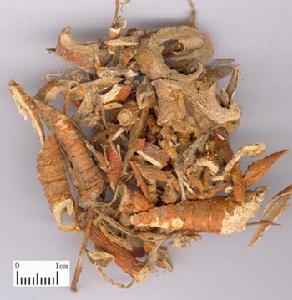Sang Bai Pi
The Processing of Sang Bai Pi
Origin
The dry root bark of Morus alba L. of family Moraceae.
Location
Most places of china.
Harvest
Collect root from late autumn to spring before sprout, scrap off yellow color crude skin, cleave along length wise, then shuck off the root bark.
The actual smell and taste
Light smell, slightly sweet taste.
Best quality
white, thick and powdery.
Processing
Washed, moistened deeply, then cut into floss, dried in the the sun; unprocessed or stir-baked with honey.
The Effect of Sang Bai Pi
Property
Sweet, cold; lung meridian entered.
Actions
Purge lung to relieve dyspnea, induce diuresis to alleviate edema.
Indications
A. Cough and dyspnea due to lung heat
Being old in nature and with actions of purging lung and relieving dyspnea and cough, it is indicated for cough and dyspnea of reversed flow of qi due to heat or water retention in the lung. It excels at purging lung to relieve dyspnea. For fever, cough and dyspnea due to congestion heat in lung and reversed flow of lung qi, it is often combined with lung-clearing and fire-purging herbs. For instance, it is mutually reinforced by Da Fu Pi in Xie Bai San. For water retention in the lung with symptoms of cough and dyspnea, fullness sensation in chest, unable to lie down, it is often combined with lung-ventilating herbs and water expelling herbs, such as Ma Huang and Ting Li Zi and so on. For lung yin deficiency with internal heat manifested as cough and dyspnea with short breath, hectic fever and night sweating, it is often combined with qi-tonifying herbs, yin-nourishing herbs and lung-astringent herbs to obtain the action of tonifying qi, clearing lung and stopping cough. For instance, it is combined with Ren Shen, Mai Dong and Wu Wei Zi, etc.
B. Edema
With actions of inducing diuresis, clearing and directing qi downward to regulate fluid passage for the dispersing of dampness, it is indicated for edema and dysuria. It is good at treating edema due to damp-heat, and often combined with heat-clearing and diuresis-inducing herbs, such as Ting Li Zi and Fang Ji, etc. For obstruction of lung qi and water retention with symptoms of edema, fullness sensation in chest, dyspnea and dysuria, it is combined with lung-ventilating herbs and exterior-releasing herbs. For instance, it is combined with Ma Huang, Xiang Ru, Chan Tui and Sheng Jiang Pi and so on. For edema due to qi deficiency, it is combined with qi-tonifying and spleen-invigorating herbs, such as Fu Ling, Yi Yi Ren, Bai Zhu and Chen Pi and so on.
In addition, it can decrease blood pressure. So it is indicated for hypertensive disease due to hyperactive of liver yang, combined with liver-heat clearing herbs, such as Xia Ku Cao and Jue Ming Zi and so on.
Dosage and Administrations
Decoct 3~10g. Take unprocessed for purging lung and inducing diuresis, stir-baked with honey for lung deficiency cough and dyspnea.
Cautions
It is contraindicated for lung cold and wind-cold cough patients for its cold and descending property. It should be used with cautions for patients with much urine.
